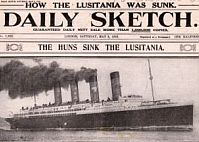 When the Cunard liner RMS Lusitania was sunk by a German submarine during World War I, on May 7, 1915, with the loss of 1,198 passengers and crew, the Germans claimed that the ship was carrying high explosives, which the British vehemently denied. The British later admitted that the ship was carrying 4,200 cases of small arms cartridges. In 1918, a New York judge ruled that that these did not constitute “war munitions”. The sinking of the ship was used by the British army for recruiting purposes, particularly in Ireland, and was crucial in swaying public opinion in the US in favor of declaring war against Germany. Newly released documents, however, raise questions about what may have been aboard the ship when she was torpedoed.
When the Cunard liner RMS Lusitania was sunk by a German submarine during World War I, on May 7, 1915, with the loss of 1,198 passengers and crew, the Germans claimed that the ship was carrying high explosives, which the British vehemently denied. The British later admitted that the ship was carrying 4,200 cases of small arms cartridges. In 1918, a New York judge ruled that that these did not constitute “war munitions”. The sinking of the ship was used by the British army for recruiting purposes, particularly in Ireland, and was crucial in swaying public opinion in the US in favor of declaring war against Germany. Newly released documents, however, raise questions about what may have been aboard the ship when she was torpedoed.
In documents from 1982 released on Thursday by the Foreign Office from the British National Archives at Kew, Noel Marshall, the head of the Foreign Office’s North America department, expressed concerns that a proposed salvage operation on the wreck of the Lusitania could still “literally blow up on us”.
Marshall wrote:
“Successive British governments have always maintained that there was no munitions on board the Lusitania (and that the Germans were therefore in the wrong to claim to the contrary as an excuse for sinking the ship)… The facts are that there is a large amount of ammunition in the wreck, some of which is highly dangerous. The Treasury have decided that they must inform the salvage company of this fact in the interests of the safety of all concerned. Although there have been rumours in the press that the previous denial of the presence of munitions was untrue, this would be the first acknowledgement of the facts by HMG.”
There has long been speculation that a second explosion heard by survivors on the Lusitania was caused by a torpedo setting off secret munitions stowed aboard the ship rather than one of the ship’s boilers exploding, as was the conclusion of the official investigation.
What do these documents mean? Was the Lusitania carrying significant munitions and therefore a legitimate target for a German U-boat? The reporting has varied widely. Saul David writing for the Guardian suggests that the documents demonstrate that the ship was carrying secret munitions. “One of the great mysteries of the first world war – whether or not the passenger ship Lusitania was carrying munitions and therefore a legitimate target when it was sunk by a German submarine in May 1915 – has been solved in the affirmative by newly released government papers.”
The BBC, hover, is not so sure, citing “confusion” : “Germany claimed the ship was carrying explosives but UK officials said there was no record of such a cargo. Now files from 1982 show confusion in government departments about whether those earlier statements were accurate.”
The Irish Times comments: “Small arms cartridges were found by the Co Waterford-based diver Eoin McGarry, on behalf of the Lusitania’s American owner, Gregg Bemis, in September 2008 in a part of the sunken liner where ammunition was never previously known to have been stored for the voyage.”
The Telegraph notes: “Since 1982, there have been a number of dives and surveys of the wreck, including one in 2012 which found no evidence of any high explosives and concluded the second blast reported by some of the 761 survivors was one of the ships boilers exploding. However the wreck’s owner, Gregg Bemis, an entrepreneur, from New Mexico, who has been trying for 40 years to ascertain if the ship had a secret military cargo, has asked the Irish Government to sanction further dives to prove his theory.”

Pingback: Gaat de ‘Lusitiana’ alsnog knallen? | Bootjesgek.nl